Make Your Experiences Count. They Can Change the World.
LET’S BRING ALL OF OUR KNOWLEDGE AND EXPERIENCES TOGETHER.
TOGETHER WE KNOW MORE. TOGETHER WE ACHIEVE MORE. TOGETHER WE DO BETTER.
LET’S BRING ALL OF OUR KNOWLEDGE AND EXPERIENCES TOGETHER.
TOGETHER WE KNOW MORE. TOGETHER WE ACHIEVE MORE. TOGETHER WE DO BETTER.
Published: July 31, 2022
My colleagues and I, part of the Salvaguarda project team, packed our bags for fourteen days in El Salvador. The trip was planned since November 2021 when we agreed on the dates and intentions of the experiences exchange between civil society organizations supported by the Austrian cooperation in El Salvador (Horizont3000, DKA and the Austrian Development Agency) and us from Conciudadanía, Colombia, who are also funded by these agencies. The goal was to identify possibilities of adopting their technologies and methodologies for our project Salvaguarda, which is funded in by the European Union.
It was my most northern trip in the Americas so far. Due to lack of knowledge, I had imagined El Salvador similar to Costa Rica: full of vegetation, like our humid jungles of the Pacific Chocó region. But I was wrong. It so happens that the territory of El Salvador is part of the Central American Dry Corridor 1, which includes portions of Guatemala, El Salvador, Honduras and Nicaragua and which in turn is part of a larger tropical dry forest that begins in Chiapas (Mexico) and ends in Costa Rica. I now understand that this has a double meaning: climatic, because in the region the effects of climate catastrophe are already strongly felt, and biological, because these are dry ecosystems. One of the characteristics of this Dry Corridor is that the drought is cyclical and lasts about two months.
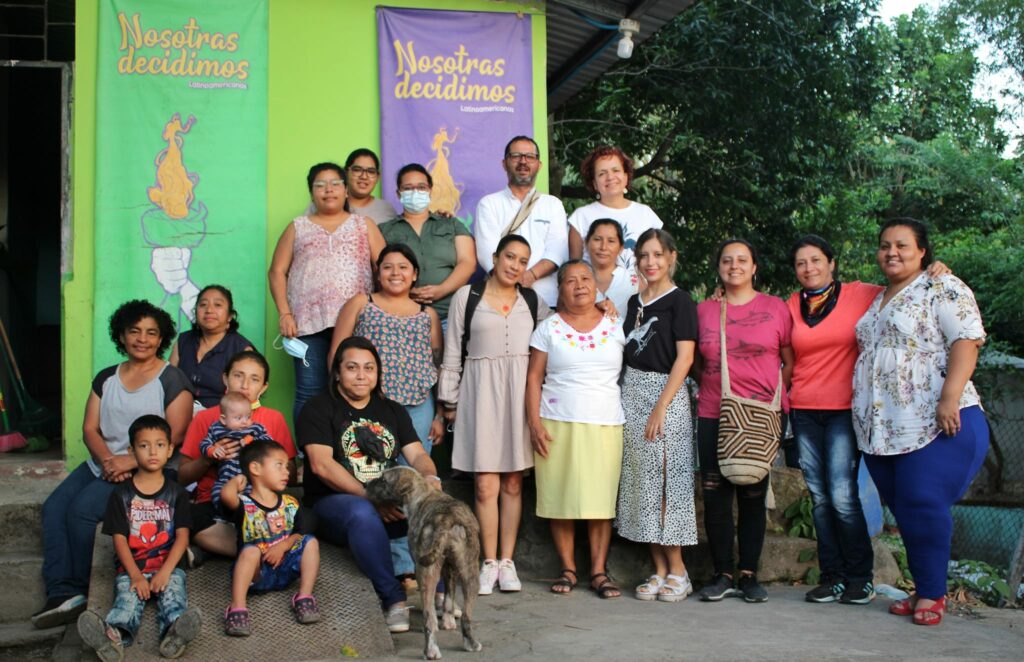
We arrived in the middle of the drought season, at the end of March 2022. It took us days to see water running over the natural watercourses that appeared dry and cobbled: “These winter streams are dry in this season; it needs to rain and recharge the aquifer for them to flow again. Before deforestation there were not so many of them because the soils retained and regulated the water better. Now it is more difficult because the soils have hardened and the water runs off and does not recharge the aquifers”. These medium altitude mountains facing the Pacific – most of them below 2,000 meters above sea level – are characterized by short micro-watersheds that do not favour the recharging of groundwater either.
We also arrived on the day that the Congress of El Salvador, at the request of President Nayib Bukele, decreed a state of emergency in the country for a month, after an unusual violent day between criminal gangs (Maras). Our friends from FUNDESYRAM (Foundation for Socioeconomic Development and Environmental Restoration) who received us in the municipality of Apaneca quickly adjusted the agendas of the visit avoiding the rural areas with more conflict. We felt safe with them and set out on the tour.

Our first stop was the municipality of San Pedro Puxtla, (to be precise, the cantons or corregimientos Cortés and Guachipilín). There we learned about the experiences of community water management in communities or veredas that receive water from an aqueduct every 6 days for 4 hours. This obliges them to store and carry water from communal wells when it runs out (it is the responsibility of women and minors). The houses that are not connected depend entirely on community wells. There we understood the importance not only of household filters to treat drinking water from wells and rainwater harvesting on roofs using 1,000-litre tanks, but also of wastewater gardens (biojardineras), which is a system which uses big containers bedded with wetland plants to treat wastewater from the kitchen and from washing clothes. This allows water to be reused in the garden. I was uneasy seeing women bathing in the communal well with buckets and in the eyes of all people. I remembered that the men of my childhood taught me to look at this rural scene with morbid curiosity.
As the comparison is inevitable – and after all this is what the visit was all about –, my colleagues and I commented on the richness of our great mountains that offer plenty of water all year round, all day long, in quantity and best quality, in most of the municipalities where Salvaguarda works. We regretted however that many rural families in Colombia have similar problems as in El Salvador. The live in dry ecosystems or in regions where water is abundant but not suitable for human consumption. We talked about the privileged place we have and how elusive climate change awareness is in our green paradise.
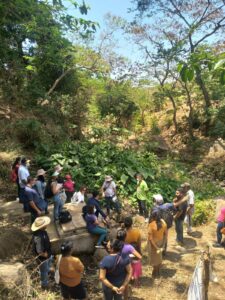
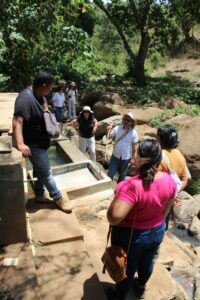
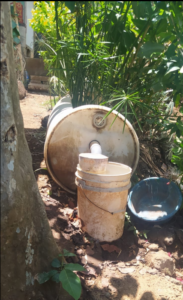
In the urban area of the municipality of Tacuba, we got to know the work of FUNDESYRAM with women and we discussed their role in the management of water and the environment. The role of women in fetching water from the community well increases their working hours, and with it their vulnerability. This is why the water harvests, wastewater gardens, and filters save them work and time. This explains the acceptance of these technologies and the success of a gender sensible approach. I was also delighted to find ways to address a question I have: how should compensation for environmental services work? Of course, you need to measure more in order to compensate correctly and to answer questions like: What is the contribution to biodiversity of four square metres of garden with such and such plants? How much is the time and cost spent by the women in the garden, how much is the contribution to healthy eating? What is the time and cost of what they do in terms of separation and management of solid waste in the house? To me it is now clear: if we measure, we can compensate.
In the midst of the drought, nature preserves sanctuaries for life. Along the rural routes around the Apaneca-Ilamatepec Biosphere Reserve, “between volcanoes, forests and coffee plantations”, I heard in FUNDESYRAM’s own words about the current crisis of coffee plantations: young people have not wanted to take over the farms and the sales of rural land for the construction of holiday homes have increased. The environmental characteristics of the shady coffee plantations, the relationship between nature and the community, the social construction of the natural landscape, – all this has been recognised by UNESCO and there even exist a territorial development plan. Although it has been difficult to manage the plan, there is an inter-institutional committee that manages and leads it. For a protected area, this is the first of its kind that I know of. We have it for the Cuenca region, the so-called Cuenca Council, but not for a protected area.
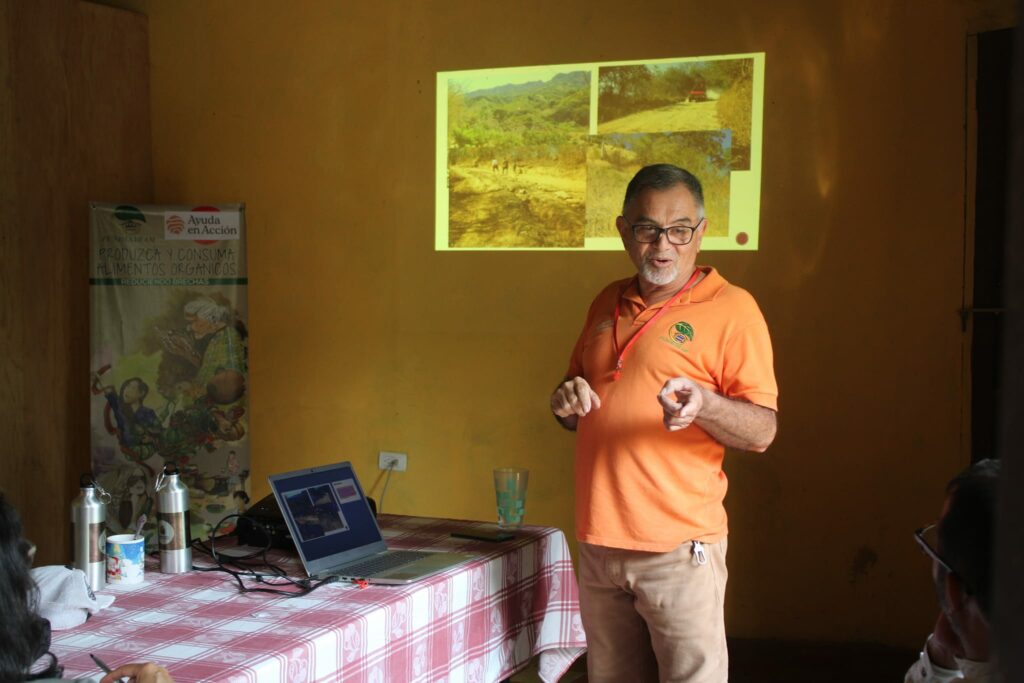
We left the north-west of the country to go to Suchitoto in the north-east. We were warned of “the heat”. We were welcomed at the Casa de Las Mujeres de Suchitoto, which houses four municipal women’s organisations, among them La Colectiva Feminista who were our dear hosts. The house was a former hospital that suffered the horrors of the civil war and was donated to the women of Suchitoto by the National Government at a time when the Minister of Health was a woman.
We were presented with the strategies of women’s work in Suchitoto and other neighbouring municipalities. I will highlight the one that most caught our attention: the referendum for the Human Right to Water. In addition to the drought seasons, these territories are under pressure from multinational companies that intend to establish farms with thousands of chickens and pigs that require water that they hope to extract from deep wells. This will put them in competition with local demands.
The first referendum was non-binding, and was held in the period 2015 – 2017. For the Feminist Collective and those interested in promoting it in general, it involved studying previously unknown issues (participation mechanisms, participation policy, electoral mechanics, and much more). It was necessary to carry out a political campaign with all its components: educational material, training activities with the communities, a municipal forum with guests from the national level – which was very important to legitimise the process.

In 2019, the referendum was repeated, seeking to make it binding and taking up several lessons. In this new phase, the strategies were reinforced: more days of training, mapping of new actors, community radio, digital media, national media, and the campaign was also taken to schools. They held a symbolic and non-binding student consultation called the CHIQUIDUI to promote the exercise of citizenship among children. They held more forums, assemblies, radio campaigning, stands with information in public places, and house-to-house campaigns. A total of 4915 votes were obtained and the consultation was binding.
Hearing about this referendum, we understood the importance of practical exercises in building political citizenship and citizen empowerment; of transmitting knowledge about the local context, external threats to water heritage, the competencies of governments and of their responsibility regarding water. We were surprised by the degree of awareness that people have about the location of water recharge zones, their role in groundwater abstraction and water harvesting, and the need for its defence, care and protection (from agro-industry, but also from fire in the dry season).
Considering the geographical, environmental, community and institutional differences, although surprised by our Latin American similarities, we arrived in Colombia full of reflections on what we could replicate in Conciudadanía. The good practices of our sisters and brothers in El Salvador inspire us to new ways of doing things.